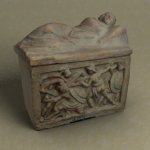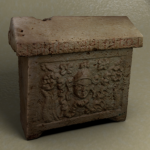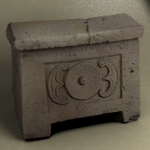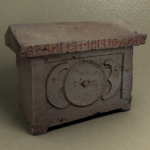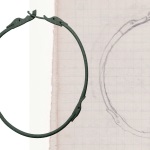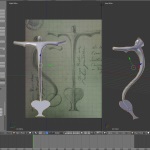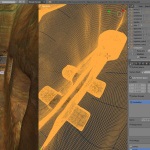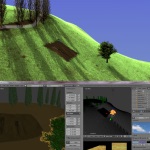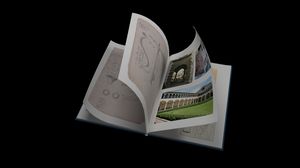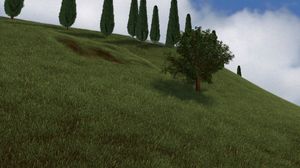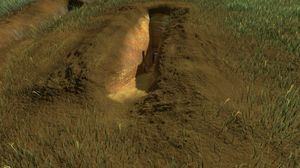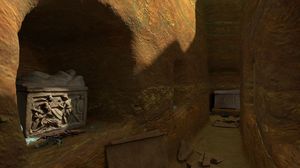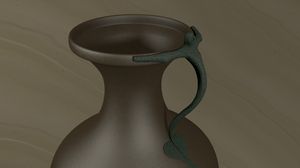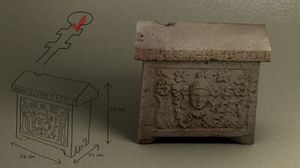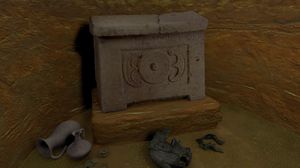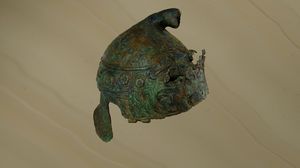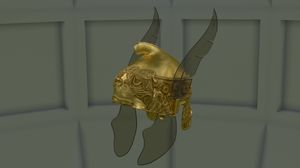Introduzione
Una morbida collina affacciata sull’antico solco vallivo del Clanis, circondata da un’alternanza di aree boscose e pianure coltivate lungo la linea di confine umbro-toscana fra Chiusi e Castiglione del Lago; due sepolcri etruschi, casualmente scoperti a fine Ottocento e poi nuovamente perduti; pagine d’archivio ingiallite dal tempo che portano i segni di accurati tratti a matita; alcuni reperti salvati dall’oblio e custoditi presso il Museo Archeologico Nazionale dell’Umbria, fra cui un pregevole casco in bronzo noto come “l’elmo di Paciano”. Questi sono gli elementi da cui ha preso le mosse il progetto TeCHe (Technologies for Cultural Heritage), frutto di una sinergia fra Soprintendenza per i Beni Archeologici dell’Umbria e Visual Computing Laboratory di ISTI – CNR di Pisa, che ha permesso di restituire coerenza interpretativa e capacità espressiva alle complementari ma eterogenee componenti disperse di un passato in frammenti ricucibile attraverso la tecnologia.
Il contesto archeologico
Il fulcro dell’intervento è stato individuato in una piccola area sepolcrale in località Sigliano-Val di Fosso (Pg), cui si riferiscono i resoconti pubblicati nel 1880 dall’Ispettore agli Scavi e Monumenti dell’Umbria Mariano Guardabassi, e dal prussiano Wolfgang Helbig, inviato in Etruria dell'Instituto di Corrispondenza Archeologica di Roma. La necropoli, risalente alla tarda età ellenistica, si inseriva in epoca antica nel distretto più produttivo e capillarmente popolato del vasto agro controllato dalla città di Chiusi, ed era composta da due ipogei scavati direttamente nel terreno caratteristico della zona, formato da una stratificazione di ghiaie e sabbie. La struttura, piuttosto semplice, consisteva in un’unica cella a pianta circolare, preceduta da uno stretto corridoio (dromos), ai lati del quale erano ricavate, nel caso della tomba I, due coppie di loculi sigillati da tegole in laterizio. Quest’ultima al momento della scoperta risultava ancora inviolata e fortunatamente completa dell’apparato funerario di urne e oggetti di corredo.
Il video
Nell'ambito degli obiettivi prioritari di progetto, è stato realizzato un video narrativo in computer animation contenente l’inquadramento geografico, le notizie sulle circostanze di ritrovamento e la ricostruzione digitale 3D dell’ipogeo I e dei suoi arredi mobili (urne cinerarie ed elementi di corredo, sia quelli conservati che quelli perduti). L'ultima sezione del video è dedicata all'oggetto di maggior rilevanza associato alla deposizione del fondatore del sepolcro. Si tratta del pregiatissimo elmo in bronzo di forma frigia, per il quale, tenuto conto dell'eccezionalità e del tenore artistico, è stata proposta una inedita veste restaurata. In questa pagina, maggiori informazioni tecniche sulla realizzazione del video.
Le urne
Quattro le deposizioni ad incinerazione che la tomba I ospitava: le iscrizioni incise sulle urne lapidee ricordano che tre dei defunti (due uomini, verosimilmente padre e figlio, e una donna, sposa di uno dei due) erano membri della influente gens chiusina dei Tetina. L’urnetta in terracotta policroma apparteneva invece ad un liberto di origini orientali, rispondente al nome di Zerapiu, che probabilmente rendeva servizio alla famiglia nella gestione della proprietà terriera. Tipologie seriali dei contenitori ed indicazioni epigrafiche corrispondono a caratteristiche tutto sommato omogenee diffuse in altri contesti funerari del territorio pertinente a Chiusi nel corso del II sec. a.C. I cloni digitali 3D dei cinerari, che si conservano presso il Museo Archeologico Nazionale dell’Umbria di Perugia, possono essere visualizzati interattivamente nel browser usando i seguenti link:
L'elmo e il suo restauro virtuale
Sia nell’attività di studio che in quella di valorizzazione e comunicazione, una particolare attenzione è stata riservata, in virtù dell’importanza storica e del pregio artistico - ma anche di una marcata anomalia sistemica, geografica e cronologica rispetto al contesto di deposizione -, al prezioso elmo frigio integrato nel corredo che accompagnava la sepoltura del capofamiglia di Sigliano, come prestigioso simbolo gentilizio di virtus guerriera e gloria politico-sociale. Non è possibile escludere che il copricapo fosse associato ad altri elementi di una panoplia militare non più conservata. Raffinato prodotto di un atelier sud italico di IV sec. a.C., inizialmente rivestito di foglia d’oro, l’elmo è stato digitalizzato e fatto anche oggetto di un restauro virtuale, nell’intenzione di riproporre visivamente la fastosissima allure che contrassegnava l’arma in origine. Sono stati dunque ripristinati, con la lucentezza dell'oro, volumi e porzioni decorative mancanti del fregio, nonchè le paragnatidi perdute e gli attributi piumati, sontuose insegne di potere militare che un tempo avevano fregiato il capo di un valoroso guerriero. Il risultato è quello di una trasformazione radicale, per certi versi sorprendente, ma scientificamente accurata, supportata geometricamente dalla simmetria di molti dei decori, e archeologicamente da confronti puntuali con altri reperti reali e testimonianze iconografiche. Il manufatto, esposto anch’esso al Museo Archeologico Nazionale dell’Umbria di Perugia, puo' essere esplorato nel 3D interattivo qui presentato, osservandolo sia allo stato attuale di conservazione, sia nel ripristino dell’aspetto antico compiuto grazie all’intervento di restauro virtuale.
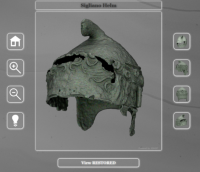
Altri elementi di corredo
Gli oggetti di corredo che affiancavano le deposizioni del capofamiglia e del liberto, rispettivamente in associazione alla teca in travertino più grande e alla cassetta in terracotta, sono rappresentati da vasellame in ceramica, per lo più di taglia miniaturistica, e frammenti metallici tra cui alcuni relativi a strigili e vasetti, che riconducono per confronti tipologici a produzioni coeve riscontrabili nella stessa area. La lacuna di informazioni generata dallo smarrimento di questi materiali subito dopo l’epoca in cui furono riportati alla luce, è stata compensata dalla conservazione di due taccuini inediti di appunti presso gli archivi della Biblioteca Comunale Augusta di Perugia e dell’Istituto Archeologico Germanico di Roma, sulla scorta dei quali è stato possibile ottenere dati qualitativi e visuali molto più dettagliati delle notizie pubblicate nei report ufficiali.
Bibliografia
- S. Batino, Frammenti di memoria dall’ager clusinus orientale. L’ipogeo dei Tetina di Sigliano, Edizioni Quasar, Roma (in corso di stampa)
- S. Batino, M. Callieri, D. Duranti, M. Dellepiane, P. Pingi, E. Siotto and R. Scopigno, Virtual reconstruction of an Etruscan tomb in CHNT 17 – Conference on Cultural Heritage and New Technologies, November 5th-7th 2012, Wien 2013, 1-13 (ISBN 978-3-200-03281-1)
Credits
Coordinamento del progetto:
- Roberto Scopigno - Visual Computing Laboratory – ISTI CNR Pisa
- Marisa Scarpignato - Soprintendenza per i Beni Archeologici dell’Umbria
Responsabili del progetto:
- Sabrina Batino - Ideazione, ricerca storico-archeologica ed archivistica
- Marco Callieri – Modelli 3D, video e galleria virtuale
Ringraziamenti
- Thomas Fröhlich - Deutsches Archäologisches Institut di Roma
- Maurizio Tarantino - Biblioteca Comunale Augusta di Perugia
- Francesco Landucci - Archeologia Sonora Sperimentale
- Daniele Duranti - Modelli 3D, scansione e modellazione
- Daniele Bernabei - Voce narrante
- Musiche originali, per gentile concessione: Francesco Landucci - Archeologia Sonora Sperimentale - www.francescolanducci.com - da: "Etrurian Imaginary Sounds"
Questa attivita' e' stata parzialmente finanziata da:
- Progetto “TeCHe - Technologies for Cultural Heritage” sostenuto da Regione Umbria (AUR - Agenzia Umbria Ricerche) con fondi POR Umbria FSE 2007-2013, Ob.2, Asse V, Obiettivo specifico “m”
- 3D ICONS - Pilot Project funded under the European Commission’s ICT Policy Support Programme


